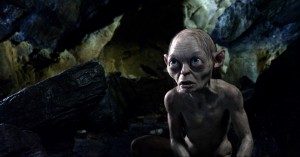Peter Jackson’s hi-def hobbits? By Richard Crouse and Ned Ehrbar Metro Canada Reel Guys December 14, 2012
 SYNOPSIS: The prequel to the immensely popular “Lord of the Rings” films is a coming of age story for Bilbo Baggins (Martin Freeman), a stay-at-home hobbit from Bag End, in Hobbiton in the Shire. He’s content with his quiet life until Gandalf (Ian McKellen), a wizard, recruits him to help a group of thirteen Dwarves (led by their king Thorin Oakenshield, played by Richard Armitage) in their quest to reclaim their former home, the Lonely Mountain, and its treasure from the dragon Smaug. It’s on this peril filled journey that Baggins matures, battles trolls, goblins and meets the creature that will shape his fate—Gollum (once again played by Andy Serkis).
SYNOPSIS: The prequel to the immensely popular “Lord of the Rings” films is a coming of age story for Bilbo Baggins (Martin Freeman), a stay-at-home hobbit from Bag End, in Hobbiton in the Shire. He’s content with his quiet life until Gandalf (Ian McKellen), a wizard, recruits him to help a group of thirteen Dwarves (led by their king Thorin Oakenshield, played by Richard Armitage) in their quest to reclaim their former home, the Lonely Mountain, and its treasure from the dragon Smaug. It’s on this peril filled journey that Baggins matures, battles trolls, goblins and meets the creature that will shape his fate—Gollum (once again played by Andy Serkis).
Star ratings:
Richard: 3 ½ Stars
Ned: 3 Stars
Richard: Ned, as much as the story and performances, people will be talking about the presentation of the movie. Shot and projected at 48 frames a second—twice the industry standard—the picture is so vivid, so pristine, it doesn’t really look like a movie. Combine that with the 3D and it’s like watching mega high-definition. Every goblin wart and troll blemish distinct enough to give dermatologists everywhere nightmares. What did you think of the mega-super-hi-definition look of the movie?
Ned: I have to say, the 48 frames per second was a problem for me. It often looked somewhere between a super-high definition 1980s BBC miniseries and a video game, and it just felt utterly un-cinematic. Saying that it doesn’t really look like a movie hits the nail on the head. Christopher Nolan has harped on in the past about film having a “warmth” that video can’t replicate, and I think I see what he means here. But the biggest crime, I think, is that the sweeping shots of the gorgeous New Zealand landscape looked fake.
RC: Perhaps it’s like the difference between vinyl or CD. I prefer the warm sound of old school vinyl to the hard digital preproduction of CD. The pops and skips are part of the experience, just as film blur and grain are a part of watching 35 mm projected on the big screen. Having said that, Gollum is awesome at 48 frames a second. The extended scene, (for the record, most of the scenes in the film could be called extended), in which Bilbo and Gollum meet and trade riddles is one of the highlights of the film thanks to Serkis’s astounding motion capture performance.
NE: That scene is the true highlight of the film, and it coincidentally is where Martin Freeman, as the younger Bilbo, really shines as well. But even with this standout, Peter Jackson and company manage to spoil it (for me at least) by overdoing Gollum’s last line to beat the viewer over the head with another reminder that all this leads to “the Lord of the Rings.” It’s a bad habit running through the film that grows tedious. Elijah Wood’s cameo is particularly clumsy in this regard, with him basically describing what he’s going to do in his first scene in “Fellowship of the Ring” and then running off to do it.
RC: It may be clumsy, but I think fans of the series will revel at the chance of revisiting the characters!
NE: Well, they’ll have plenty of chances. If you like this one, the good news is it’s just the first of three movies.
Leave a Reply
You must be logged in to post a comment.
